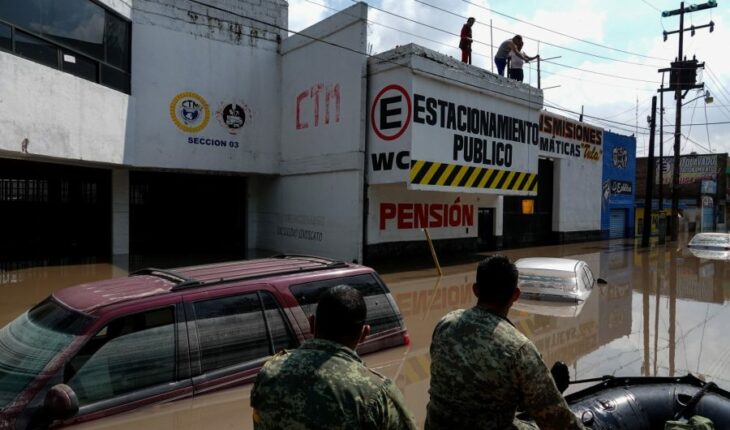The Water System of Mexico City (Sacmex) definitively reserved, for three years, the operating logs of the metropolitan drainage corresponding to September 6, 2021, prior to the overflow of the Tula River that caused the death of 14 people.
Political Animal documented that the flood was due to the fact that federal and capital authorities made the decision to send sewage to the municipality of Hidalgo to avoid affecting the CDMX. The federal government acknowledged that the amount of water sent was excessive and exceeded the carrying capacity of the Tula River, causing it to overflow.
Through requests for transparency, this means required Sacmex – one of the three authorities that are part of the Metropolitan Drainage Commission – the logs in which they record, hour by hour, the storage levels, gate positions and pumping levels in emitting tunnels, dams, lights, regulation lagoons and pumping plants of the metropolitan drainage system between August 30 and September 18, that is, one week before and two weeks after the Tula flood.
Access to this information would allow us to know how much water could be stored in the CDMX drainage system before expelling it to the Tula River, and whether this decision was an inevitable issue, according to specialists consulted.
Likewise, the information would allow to know if the Metropolitan Drainage Commission emptied to sufficient levels the regulatory systems of the city before the forecast of important rains a week before the disaster, as indicated in the Protocol of Joint Operation of the Hydrological System of the Valley of Mexico, a document that governs the action of the tripartite body, in which the National Water Commission (Conagua) participates. the Water Commission of the State of Mexico (CAEM) and Sacmex.
After a process of seven months through the National Transparency System, Sacmex finally decided to deliver the tested logs: hundreds of pages in which the primary information was crossed out so that its content cannot be known. Below is an example of the documents as they were delivered by the capital institution.
The Sacmex Transparency Committee, in its sessions on March 8 and April 28, endorsed the reservation of the information for three years because, supposedly, these documents contain information that may put engineers at risk and promote the sabotage of infrastructure considered strategic. However, the requests for information made are not related to the location of facilities or their technical characteristics, but to administrative decisions and storage levels in a specific period, by virtue of rainfall phenomena that have already concluded and that are unrepeatable.
Sacmex even argued that releasing the requested data on three regulatory vessels, nine dams, six pumping plants and 17 luminaries could affect the tax collection of the Cdmx Government and put at risk the health of the capital.
The agency added that other local and federal institutions (CAEM and Conagua) participate in the operation of the metropolitan drainage, so delivering the logs would exceed its own scope of action and would invade the competences of the other instances.
“The logs have strategic information related to technical and specific data of the hydraulic infrastructure (primary and secondary network) through which drainage and wastewater services are provided,” say the minutes of the Sacmex Transparency Committee.
“Therefore, the damage that can occur with the publicity of the information is greater than the public interest of knowing them, which would entail an undue advantage, putting at risk or violating the correct management and safety of the facilities and operators by threat, disablement, destruction, sabotage, blockage of pipes, causing the obstruction of the continuous flow and quality, which has an impact on the tax collection for granting an ineffective service, and even alterations in health and / or public services provided to this city, and the collateral damage that could socially affect the surrounding neighborhoods or other facilities such as cable, electricity, telephone, among others, as well as alter the operation of a gate or the start and stop systems, being the same case for pumping equipment, in the opening-closing or commissioning times sabotaging the operation, which could burn or steal some material resource, such as starting systems, pumps or cables (sic)”.
Political Animal requested the directorateA position on the confidentiality of information is the social communication of the unit. In a brief statement sent to this media, the area reiterated that the purpose of this measure is to preserve the safety of the hydraulic facilities of the capital.
“Any information, documentation or characteristics that have the particularity of strategic in the hydraulic infrastructure and its facilities are considered restricted access in their reserved modality. Under this criterion, what is sought is to avoid or minimize any risk or threat to the facilities of the hydraulic infrastructure of Sacmex, as well as that shared with Conagua and CAEM, in accordance with the provisions of the Political Constitution of the United Mexican States, “he said in his response.
Specialist warns of cover-up
The path to obtain the operating logs of the metropolitan drainage system has been consistently obstructed by Sacmex through maneuvers such as the extension of deadlines, the omission of responses and unjustified denials of information.
The irregularities have merited the intervention of both the Institute of Transparency of the capital — which opened the review resources INFOCDMX/RR/IP.1995/2021, 1996/2021, 1997/2021 and 2117/2021 — and the INAI, which initiated the appeal of non-conformity RIA-432/21.
In the review appeals, INFOCDMX ordered Sacmex to issue a well-founded and justified response. Seven months after it received the transparency requests (they were entered on September 28, 2021), Sacmex proceeded to “substantiate” and “justify” in its Transparency Committee why it could not deliver the required logs. This decision constitutes the last phase of the administrative process of access to information. The only citizen remedy left to challenge it is to go to the Judiciary.
Subject to the fact that the Attorney General’s Office (FGR) – which initiated an investigation file for culpable homicide and negligence – requires Sacmex to deliver these technical documents, citizens, and especially the victims of the tragedy, will be denied access to truth and justice, says Dean Chahim, an engineer and anthropologist expert in the metropolitan drainage system.
“It seems to me that they want to leave the public in that state of ambiguity of not denying or accepting (responsibility). It’s like what the president himself did to say ‘I’m responsible, but I’m not guilty,'” Chahim said in an interview. “That kind of ambiguity is very productive for them, because it leaves out of our reach a conclusive proof of what, in some way, we already know happened, we know the result, we know that the water sent by Sacmex and Conagua detonated the flood, we have already verified and explained it many times, but, for the purposes of justice, a historical truth, these logs are needed, because they are the only record of the movement of the waters within the drainage system,” he says.
The researcher points out that the operation logs would allow to determine if it was really impossible to contain in the CDMX the sewage and rainwater instead of diverting them to Tula on the night of September 6, 2021.
“That is precisely why they do not want to disclose these data, because this can open the possibility of a secondary analysis by researchers, journalists, technicians and by the general public, to think and rethink what we could have done differently,” says the academic.
“And that’s the saddest thing about this, because, without opening that, you’re never going to be able to really have that discussion at the technical level and at the political level, that, when we have a similar circumstance, in which the entire drainage system is filled and an area has to be sacrificed, who are we going to sacrifice? We already know that they made the decision to sacrifice Tula to sewage, but the question is: could we have affected more equitably? We don’t know, and that’s just what they’ve done to us: leave us without the power to know, and that’s very cynical on sacmex’s part and very contrary to scientific issues.”
Chahim, who is about to publish a book on the political management of metropolitan drainage, argues that collectively a discussion should be opened about the alternatives of the wastewater and rainwater management model, and move to a scheme that does not involve putting the lives of marginalized communities at risk.
“As an academic and researcher, I understand what happened in broad strokes, you should not have the logs to understand ‘broadly’, but, to verify in legal terms what happened and look for those responsible, and also glimpse what alternatives there are (towards the future), you need to be able to assemble a hydraulic model of the system, for which you would need to the data that is justly crossed out in the logs. I do believe that they seek to avoid legal liability, but I also think that something important is that the responsibility is not of a single person, it is also a failed system, and that is what has to be understood, “says the expert.
What we do at Animal Político requires professional journalists, teamwork, dialogue with readers and something very important: independence. You can help us keep going. Be part of the team.
Subscribe to Animal Político, receive benefits and support free journalism.#YoSoyAnimal





